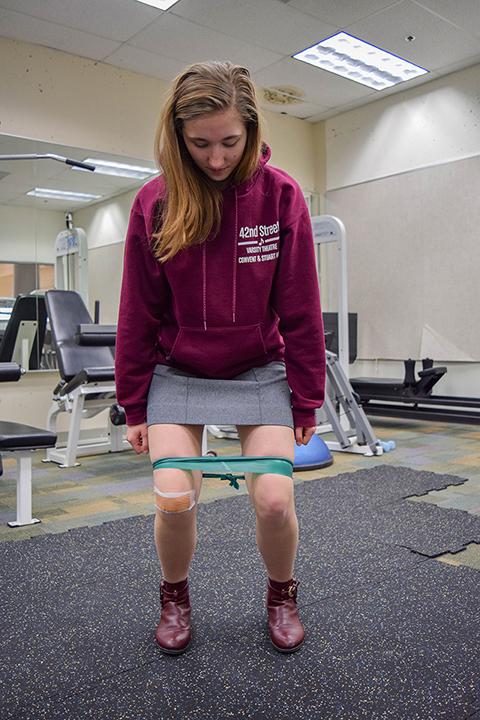Injuries that knee-d to be addressed
Knee problems required injured to find alternatives to workouts, sports and daily activities.
Senior Cat Heinen squats with a stretch band in order to help re-align her knees from patellofemoral syndrome, knee pain caused by outer leg muscles pulling the kneecaps the wrong way. Heinen performs a set of exercises and stretches every day including squats and leg extensions.
March 15, 2016
Climbing up the 10 flights of stairs from the Syufy Theatre to the Flood Mansion third floor is exhausting for most students, but for senior Cat Heinen, it literally is painful.
“I have patellofemoral syndrome, which means my outer thigh muscles pull my kneecaps the wrong way, so when I go up or down stairs, it puts the wrong pressure on my kneecaps,” Heinen said. “I dance, but ballet requires you to use different muscles, so my knees don’t hurt because I’m using the right muscles to keep my knees in place.”
Patellofemoral syndrome is one of the most common causes of knee pains for teenage athletes, especially for girls, who can easily overuse their knee during sports and workouts, according to the American Academy of Orthopedic Surgeons.
Also known as anterior knee pain, patellofemoral syndrome can be caused from an unaligned knee cap or overuse of the knee, which wears down the cartilage under the kneecap, according to Dr. James Chen, an orthopedic surgeon who specializes in sports medicine.
Heinen began experiencing pain in her right knee last August and was diagnosed in November. To alleviate the pain, she does a series of stretches and exercises for 10 to 15 minutes a day at home.
Sophomore Jocelyn Shilakes was diagnosed with patellofemoral syndrome during last year’s track season when she had reoccurring pain in her knee.
“I went to physical therapy for eight weeks during the winter to try to strengthen my leg and different muscles around my knee,” Shilakes said. “Within the first few weeks of the track season this year, I had to talk to my coaches and adapt my workouts to best fit the injury that I have.”
Shilakes wears a patella band below her kneecap during physical exercise.
“The band puts pressure on the patella’s muscles,” Shilakes said. “It helps to compress it so it aligns properly when I’m exercising.”
Staying fit and lean can put less stress and weight on the joints in the knee, which can ultimately prevent the syndrome, according to Chen.
“Like any joint, the knee joint must be very tight and stable and have all of its cushion,” Chen said. “The most important thing in your knee is the cartilage. Once you wear it out, you can’t get it back. You can get a knee replacement, but that’s a pretty drastic measure.”
Chen recommends those who suspect they have a knee problem to visit a doctor immediately to prevent further complications in the treatment of the injury.
“Sometimes, we need to take X-rays to make sure bones are not broken,” Chen said. “Or we need to get a MRI that can look at all the structures in the knee, including the tendon, cartilage and the ligaments.”
Patellofemoral syndrome has not stopped Heinen or Shilakes from participating in sports, although they must modify their exercise.
“I see the athletic trainer at Stuart Hall,” Shilakes said. “I also run less than others and I do more cross training, like biking and weights, and technical work when I am not running.”










